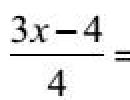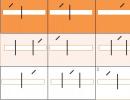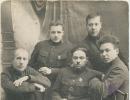"Hawk" - aviation special forces. Aviation of the Ministry of Internal Affairs of Russia History of the emergence of internal troops
The Internal Troops of the Ministry of Internal Affairs of the Russian Federation trace their history back to the Internal Troops of the Ministry of Internal Affairs of the USSR. With the collapse of the USSR, the former Soviet internal troops were divided among the former Soviet republics along territorial lines.
By the Decree of the President of the RSFSR dated October 20, 1991, all formations of the Internal Troops of the USSR Ministry of Internal Affairs stationed on the territory of the RSFSR were accepted under the jurisdiction of the RSFSR and subordinated to the Ministry of Internal Affairs of Russia.
The internal troops of the Ministry of Internal Affairs of Russia acquired official status on September 24, 1992, with the adoption of Law of the Russian Federation No. 3534-1 “On the internal troops of the Ministry of Internal Affairs of the Russian Federation.”
Until 1996, they provided security for correctional institutions, and the functions of escorting special contingents - until January 1, 1999.
Chechen conflict
Internal troops of the Russian Ministry of Internal Affairs participated in establishing constitutional order in the North Caucasus during two Chechen wars. See main articles:
Internal troops ensured order in the North Caucasus, performing the tasks of patrol and guard service and prompt response to emerging unrest.
In modern Russia until 2016
On March 2, 1993, on the basis of the regional departments of the Internal Troops of the Ministry of Internal Affairs of Russia, the following districts of internal troops of the Ministry of Internal Affairs of Russia were created: Eastern, Volga, Northwestern, North Caucasian, Siberian, Ural, Moscow. The districts existed until January 1, 2008.
Until 2016, the internal troops of the Russian Federation were an association specialized for maintaining law and order within the state. Modern internal troops were sufficiently motorized, operational (motorized rifle) units had armored vehicles. The internal troops had their own aviation squadrons, engineering and small naval units.
The internal troops of the Russian Ministry of Internal Affairs continued to develop and improve, gathering experienced personnel from the armed forces of the Russian Federation and special services (
Special purpose aviation detachment of the Special Purpose Center for Rapid Reaction Forces and Aviation of the Ministry of Internal Affairs of Russia (AOSN “Yastreb” TsSN SR Ministry of Internal Affairs of Russia) - “Yastreb” is aviation special forces. The center is operationally subordinate to a unit of the central apparatus of the Russian Ministry of Internal Affairs, which implements the functions of the Russian Ministry of Internal Affairs in organizing the activities of the rapid reaction forces.
The head office of the AOSN "Yastreb" TsSN SR Ministry of Internal Affairs of Russia is located in the Aviamotornaya metro area. Here the detachment has a spacious, renovated office building

We are met and will be accompanied in the future, told and shown everything - deputy commander of the special purpose aviation detachment "Yastreb" of the Special Purpose Center for Rapid Reaction Forces and Aviation of the Ministry of Internal Affairs of Russia for flight work - Yumaev Marat Abdrashitovich, police colonel

Since the detachment is aviation, there is a helipad on the roof of the office building

The dispatcher prepares for the arrival of a helicopter

Helicopters of the Yastreb aviation detachment are based at the Chkalovsky airport near Moscow. Travel time from Chkalovsky to the office by helicopter is about 10 minutes.

The helicopter is controlled by the commander of the Yastreb flight squad. After posing for us, the helicopter flew back to the Chkalovsky airfield to wait for us there.

In the meantime, we have the opportunity to see the life of an aviation detachment.
Class

Police officer studying technical materials

Layout diagram of the main airfields (sites) in the Moscow hub control area with communications and radio information data

It has its own small gym, although the employees don’t have much free time.

It can be seen that the building has been completely renovated, everything is new everywhere and everything is clean and tidy, just like home

The Yastreb aviation detachment is relatively young in state aviation; in 2013, the detachment was only 10 years old.

The unit is proud of them. I serve the law - I serve the people!

A portable small-sized complex that includes two aircraft, a compact control station with a spare set of batteries for the aircraft and a backpack container for carrying 2 UAVs. This reliable complex is designed for use in the first line of reconnaissance, as well as for observing the surface of land and sea. The time required to prepare the kit into working condition is 5 minutes. ZALA 421-08 is controlled in automatic or semi-automatic mode.

The detachment is constantly developing, new equipment and equipment are purchased. The squad of unmanned aerial vehicles is working hard, the workload is crazy. The detachment is assigned to the region and the nearest districts (Kaluga, Tver regions, seven regions in total)

Aircraft-type unmanned aerial vehicle ZALA 421-16E. Aircraft-type UAVs develop high speed and can fly at a distance of up to 50 kilometers, while from a distance of up to 25 kilometers, an unmanned “baby” can broadcast video images to the base, and it can conduct autonomous shooting while being at a distance of up to 50 kilometers from the operator. If the signal is lost, the drone returns to the base on its own.

Bloggers carefully study unmanned aerial vehicles

A closed video communication system where you specify where the aircraft will fly, and you can immediately monitor in real time where the drone is. UAVs are a special pride of the aviation squad.

These helicopters have nothing to do with the Yastreb squad, but I just couldn’t pass by, still beautiful KA-226 machines

Helicopters for decommissioning...waiting in the wings

We are met by Igor Leonidovich Konshin - police colonel, commander of the Yastreb flying squad.

Igor Leonidovich spoke a little about the "Hawk" detachment
The Yastreb aviation detachment is relatively young, but during this time it has undergone tremendous development. If you look at how we were based initially, we sat in small, shabby offices on Bolshaya Lubyanka and now we have a large, renovated office building. Previously, the detachment was based in Bykovo, but unfortunately Bykovo airport, which is very conveniently located geographically for carrying out tasks, was closed. We found a place for ourselves to be based on helicopters and, plus, to have an airplane nearby. We began to be based at Chkalovsky and Ramenskoye airports. We have a scattering of aviation equipment, this is done specifically to carry out tasks; if all the equipment is in one place, then this will not be correct. It would seem that Chkalovsky and Ramenskoye are nearby, but the weather can be radically different. There may be an open sky in Chkalovskoye when Ramenskoye is closed. Therefore, this allows us to quickly complete assigned tasks. We fly helicopters in almost all weather conditions. All the pilots of the detachment went through fire, water and copper pipes, all were former military pilots.
In Chkalovsky we have 1 helicopter crew on duty around the clock, with a total of 5 people on duty shift. Ready for departure in 20 minutes.

There are two hangars on the territory. One, as it were, is divided into a household block and a garage for special equipment.

Igor Leonidovich: “The management has a lot of plans for development. I would like people to come to duty as if it were home, for this purpose comfortable conditions are created for serving.”
In the kitchen, where the duty shift eats, the cat Klyopa lives :)

There is a small recreation area with strength training equipment and tennis tables.


The main striking force of the Yastreb AOSN is the light multifunctional helicopters AS-355 Ecureuil (translated from French as squirrel) produced by the French aircraft manufacturing concern Eurocopter.
One of the helicopters bears the name Alexander Kalabushkin (named in honor of a deceased squad member); it was this helicopter that was flown by Igor Leonidovich when we were on the roof of the office building.

Pilot's seat in the AS-355 helicopter

One of the helicopters is painted to resemble a camouflage, the other in police colors. The squad is given different tasks and some tasks require one coloring, others another. This helicopter was used to film the inauguration of Russian President V.V. Putin

One of the most important and responsible areas in the work of the air squad is interaction with special forces units. First of all, with the SOBR "Lynx" and the riot police "Zubr". Here, the main task of police aviation is to transport the combat group to the site of the special operation. The helicopter can carry up to 4 employees with weapons and in full gear. Special forces can be located not only inside the helicopter, but also outside. In addition to transport and combat functions, the helicopter performs reconnaissance missions using special equipment.

Maximum flight altitude is 6 km, speed is 250 km/h. The most important requirement for a police helicopter is maneuverability. Despite the fact that a helicopter does not have to fly often in urban areas, and its main field of activity is large open spaces, albeit within the city, a rotary-wing police officer must still be prepared for the fact that he will have to maneuver with small turning angles and soar sharply into the sky or descend if necessary. The AS-355 is ideal for such maneuvers. Another undeniable advantage of this machine is its weight and dimensions. Thanks to its modest size, the helicopter can, if necessary, land on an area no more than 30 meters in diameter and at the same time land on almost any site, including the roofs of high-rise buildings. Moreover, the machine is capable of operating not only in flat conditions, but also in the mountains, and this environment, as you know, is considered one of the most difficult for flights.


A towing vehicle for a helicopter, with the help of which the helicopter is kicked out and hidden in a hangar

To perform tasks, the helicopter is equipped with high-resolution video cameras, thermal imagers and other equipment.

Igor Leonidovich: “Two years ago, the Sukhoi SuperJet 100 arrived at the detachment (which should replace the ancient and slow Yak-40”), and for a year and a half they knocked out the crew for the plane. While staff reductions are taking place in the Ministry of Internal Affairs, we were able to increase our staff from 73 people to 95.
- As it turns out? It’s just that, you have to work, knock on all doors and everything will be fine :) (Cognac does not flow under a lying officer))"
I am proud of my squad and my team!
Fasten your seat belts, we're going on a mission!

I would like to say a huge thank you to Marat Abdrashitovich Yumaev and Igor Leonidovich Konshin for the invitation to visit. Good luck to you in your difficult task! and also thanks to the mosblog community

And at the base at Chkalovsky airport, near the Yastreb aviation detachment, there lives a charming dog :)) who was very happy to see us all and even started dancing :))

Peaceful skies above everyone!
On the eve of Defender of the Fatherland Day, the air special forces of the Russian Ministry of Internal Affairs invited them to visit, show and talk about their service at the Moscow headquarters and at the base in Chkalovsky.
We started from the headquarters office in Moscow. It turned out to be an excellent, renovated, equipped building that allows you to perform assigned tasks in comfortable conditions and relax after/between tasks.
We were greeted by a stylishly decorated squad totem.
A helicopter was supposed to arrive and we were offered to spot it from the command tower, where we went up.
Means of communication with crews. 
Weather instruments 
Fire hydrant on the helipad 
Nearby there is one special service directly related to the president and they still have Volgas in service (3102 - maybe the famous ones with a V8 and a stove in the trunk?), and not just Gelikas) 
And then we heard him... 
AOSN commander, police colonel Igor Konshin, is at the helm. 


There is a touch 

Colonel Konshin made several beautiful passes and flew to Chkalovsky to work and wait for us 

Video Full HD
And then the deputy commander of the AOSN showed us the offices and rooms
In the pre-flight preparation room there are pictures of the instrument panels of the devices used. This is from Eurocopter 
The picture speaks for itself. We'll go there later 
Spur) 
One of the photos hanging on the wall, depicting the “everyday life” of the detachment 
History of AOSN 
AOSN employees honor the memory of their comrades and have memorial stands for each in the briefing room. 
Police Officer's Bible 
Coat of arms of the AOSN 
What would it be like in the modern world without UAVs? We were shown UAVs actively used by the detachment.
This is a ZALA 421 UAV of several models produced in Izhevsk. Equipped with cameras, including thermal imagers and night mode. And they showed what shooting from a UAV looks like.
ZALA 421-04M, with slingshot launch and parachute landing. Actually standing on his slingshot. 
ZALA 421-08, also with slingshot launch and parachute landing, but a person is used as a slingshot) 
ZALA 421-16E, more than the previous 2, with a similar launch and landing 


Look into your eyes! camera) 
Hexacopter ZALA 421-21 


UAV control station screen 
From the history of the squad 
There is also a gym for employees to keep themselves in good shape. With a tennis table (I'm jealous) and visual posters for working out muscles 
And with a dude named Torneo to let off some steam)) 
Before moving to Chkalovsky, we were offered to replenish energy supplies in the detachment’s canteen, which we did with pleasure. It was delicious, no hardcore in the form of sandwiches/McDonald's for dry food for the employees, only delicious healthy wholesome food for comfortable service. 
The AOSN helicopter base is located next to the Chkalovsky airfield on the territory of the Kamov\Mil LIK. Therefore, the detachment’s area of responsibility includes not only Moscow and the region, but also the regions nearby.
AOSN owns 4 aircraft - 2 Eurocopter AS-355 on the territory of LIK, behind the “fence” from LIK at Chkalovsky Yak-40 and a Superjet in Ramenskoye. Previously, the equipment was based in Bykovo, which was very convenient for the detachment, but due to the closure of the airport, the detachment was relocated to Chkalovsky.
Only pilots with combat experience are accepted into the detachment.
Upon arrival at the place we saw Mi and Ka
Ship-based Ka-32(?) 

A tour of the base was given to us personally by the commander of the AOSN, Colonel Igor Konshin, who demonstrated the AS-355 in flight to us in Moscow. A person who lives in the squad, cheers for it and creates all the conditions for comfortable and excellent work for the squad members. 
At the base, the premises, just like in Moscow, are decorated with photographs of the detachment’s activities, as well as artwork (probably by employees). This one from the Mi-17 hangs in the pre-flight preparation room. 
Just like this small historical stand 
Pre-flight information board 
Infostar (the main subject of filming for visiting media) and the favorite of the base, kitty Klepa 
After showing us several rooms (radio, training room, duty crew room - 24 hour shift, time from receiving command to departure 20 minutes) we were taken to the most interesting thing - hangars with equipment.
In the first hangar there is service equipment
The deicer is new and there was also a tractor, aka a ground power source on the Ural chassis 
In the second hangar, the main strike force of the AOSN is Eurocopter AS-355 helicopters 

The tail of the same one that flew in front of us in Moscow 

We climbed and photographed helicopters from the chassis to the blades) 

The gray one, Alexander Kalabushkin, is named after Major helicopter crew commander Alexander Kalabushkin, who died while performing a mission in Chechnya. So if you see such a helicopter in the sky, you know that it is AOSNA 
Below is a block with cameras 
Andrey kronos
in the gray cabin 
I'm the Police) 

Cabin white and blue 
And his tidy 
Tidying up gray and displaying video from a hanging camera. The tidy is slightly different from the white and blue tidy 
On March 27, 2014, the Internal Troops of the Ministry of Internal Affairs of Russia celebrate the 203rd anniversary of its formation. Law enforcement troops trace their history back to the military battalions of the internal guard, which were formed in provincial capitals by decree of Emperor Alexander I on March 27, 1811.
Today, the Internal Troops of the Russian Ministry of Internal Affairs are one of the main operators of Il aircraft. The flagship of the Internal Troops aviation is the Il-76 heavy military transport aircraft.
On the eve of the holiday, representatives of Il OJSC visited the Ermolino airfield in the Kaluga region, where the 70th separate mixed special-purpose aviation regiment of the Internal Troops of the Ministry of Internal Affairs of Russia is stationed. The regiment is armed with several types of aircraft, including the Il-76M and Il-76MD military transport aircraft. The regiment is commanded by Colonel Ivanov Alexander Ivanovich.
One of the regiment's Il-76MD aircraft is named after Vladimir Mikhailovich Ponomarev, the first chief of aviation of the Internal Troops of the Russian Ministry of Internal Affairs.
The solemn ceremony of assigning an honorary name to the aircraft took place on February 28, 2008.
Vladimir Mikhailovich Ponomarev was born in 1935. Graduated from the Balashov Military Aviation School for Pilots. From 1957 to 1978, he served in various military positions as commanding flight personnel in the Border Troops, and personally mastered the Li-2, Il-14, An-26, Il-76 aircraft, and the Mi-8 helicopter. Participated in combat operations in Afghanistan. For courage and bravery in performing combat and special missions, he was awarded the Order of the Red Star, "For Service to the Motherland in the Armed Forces of the USSR" III degree, medals, and he was awarded the honorary title "Honored Military Pilot of the USSR."
Vladimir Mikhailovich Ponomarev regularly carried out responsible tasks for transporting members of the government of the USSR, the Russian Federation, and heads of the Ministry of Internal Affairs.
Having retired from the Internal Troops upon reaching the age limit for military service, Vladimir Mikhailovich remained an active pilot, continuing to train future pilots in the ROSTO organization.
Major General Ponomarev passed away in 2007, but the Il-76MD "Vladimir Ponomarev" aircraft named after him immortalized the memory of the professional aviator who dedicated 42 years of service to the skies of his homeland.
For reference
Ermolino airfield was built in 1938, and was originally used as a military unpaved airfield. In 1954, it was transferred to the jurisdiction of the USSR Ministry of Radio Industry, and in 1965, construction began on concrete parking lots, taxiways and a runway (3000x60 meters), which was put into operation in 1973. Aviation of the internal troops of the Russian Ministry of Internal Affairs has been based at the Ermolino airfield since 1992.






The team of OJSC "IL" congratulates the personnel of the Internal Troops of the Ministry of Internal Affairs of Russia on the holiday, wishes them well-being and peaceful skies above their heads!
Aviation of law enforcement forces today are aviation regiments and individual squadrons that transport personnel, weapons, combat and special equipment, and other materiel, support the actions of internal troops and internal affairs bodies when they carry out tasks to ensure a state of emergency, and combat organized crime. in armed conflicts, emergencies and other emergency circumstances.
Aviation Day of the Internal Troops of the Russian Ministry of Internal Affairs is celebrated on March 3. It was on this day in 1978 that the Decree of the Central Committee of the CPSU and the Council of Ministers of the USSR “On strengthening the protection of artificial structures on the Trans-Baikal and Far Eastern Railways” was issued, according to which the formation of new military units of internal troops began in the eastern part of the country. The 1st separate aviation squadron of the internal troops was formed in Khabarovsk.
The aviation of the internal troops is headed by the Deputy Commander-in-Chief of the Internal Troops of the Ministry of Internal Affairs of the Russian Federation for Aviation - Head of the Aviation Directorate of the Main Command of the Internal Troops of the Ministry of Internal Affairs of Russia, Lieutenant General Alexander Ivanovich Afinogentov.
The 70th separate mixed special purpose aviation regiment of the Internal Troops of the Ministry of Internal Affairs of Russia is stationed at the Ermolino airfield in the Kaluga region. The regiment is commanded by Colonel Ivanov Alexander Ivanovich.
One of the regiment’s Il-76MD aircraft is named after Vladimir Mikhailovich Ponomarev, the first chief of aviation of the Internal Troops of the Russian Ministry of Internal Affairs.
Vladimir Mikhailovich Ponomarev was born in 1935. Graduated from the Balashov Military Aviation School for Pilots. From 1957 to 1978, he served in various military positions as commanding flight personnel in the Border Troops, and personally mastered the Li-2, Il-14, An-26, Il-76 aircraft, and the Mi-8 helicopter.
Participated in combat operations in Afghanistan. For courage and bravery in performing combat and special missions, he was awarded the Order of the Red Star, “For Service to the Motherland in the Armed Forces of the USSR”, III degree, medals, and was awarded the honorary title “Honored Military Pilot of the USSR.”
Vladimir Mikhailovich Ponomarev regularly carried out responsible tasks for transporting members of the government of the USSR, the Russian Federation, and heads of the Ministry of Internal Affairs. Having retired from the Internal Troops upon reaching the age limit for military service, Vladimir Mikhailovich remained an active pilot, continuing to train future pilots in the ROSTO organization.
Major General Ponomarev passed away in 2007, but the Il-76MD “Vladimir Ponomarev” aircraft named after him immortalized the memory of the professional aviator who dedicated 42 years of service to the skies of his homeland.
For reference
Ermolino airfield was built in 1938, and was originally used as a military unpaved airfield. In 1954, it was transferred to the jurisdiction of the USSR Ministry of Radio Industry, and in 1965, construction began on concrete parking lots, taxiways and a runway (3000x60 meters), which was put into operation in 1973. Aviation of the internal troops of the Russian Ministry of Internal Affairs has been based at the Ermolino airfield since 1992.






